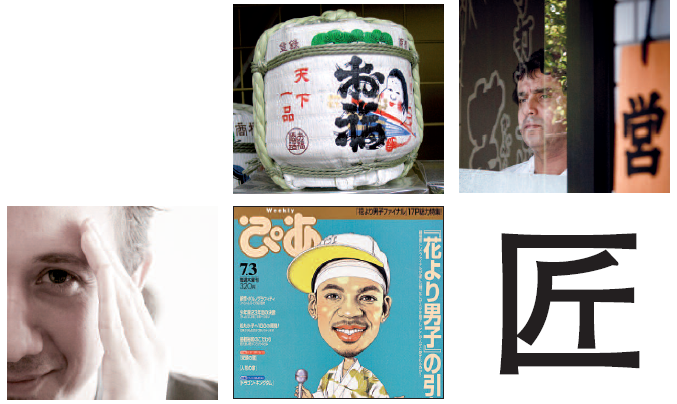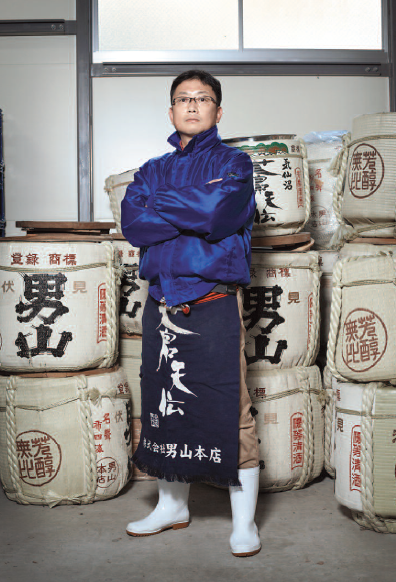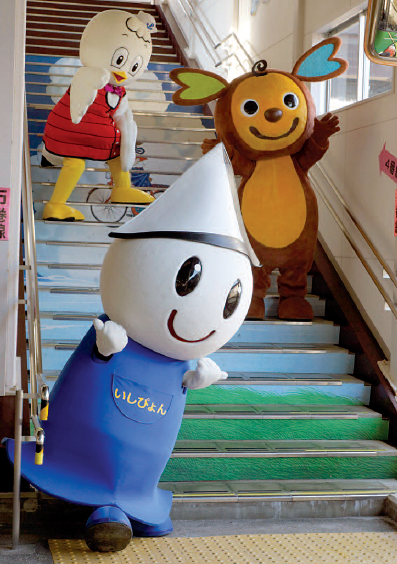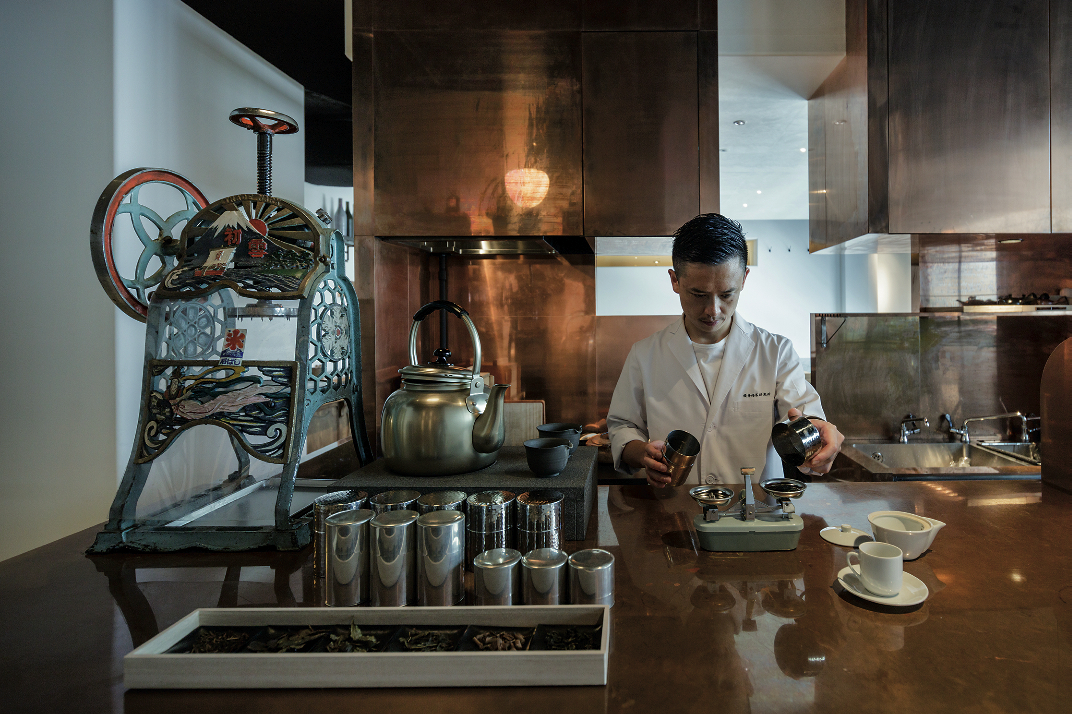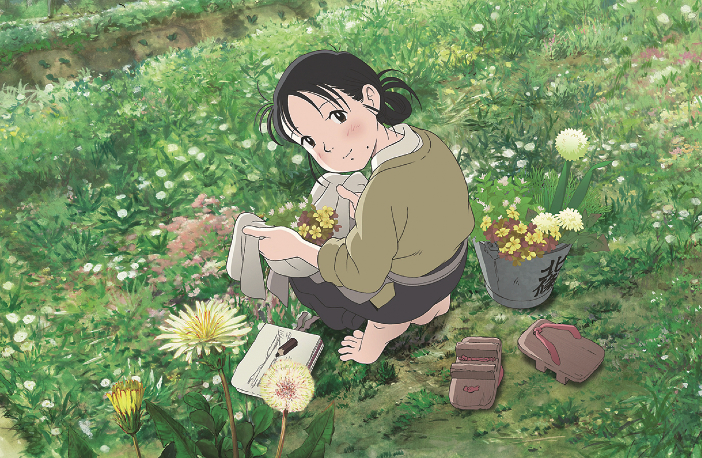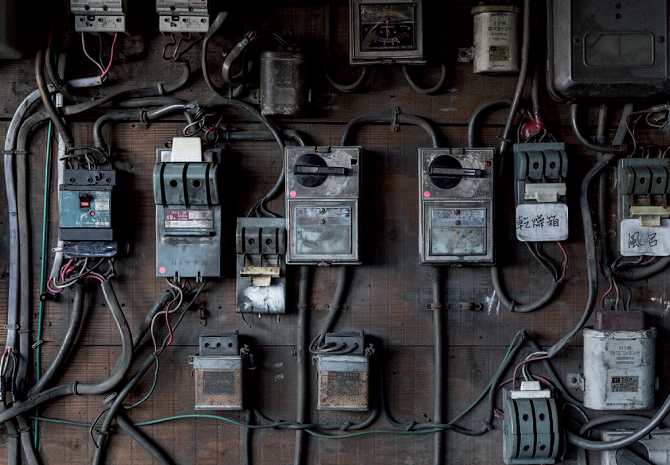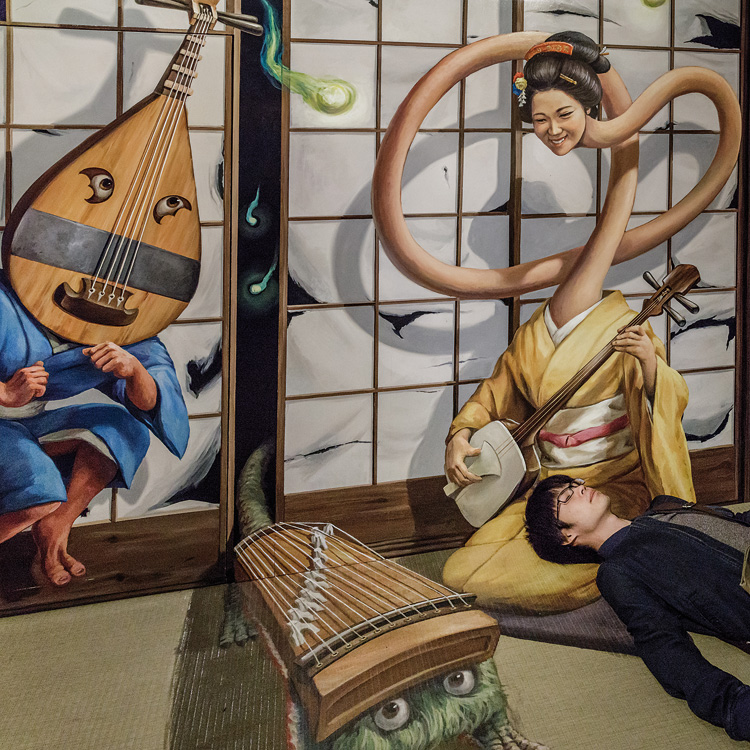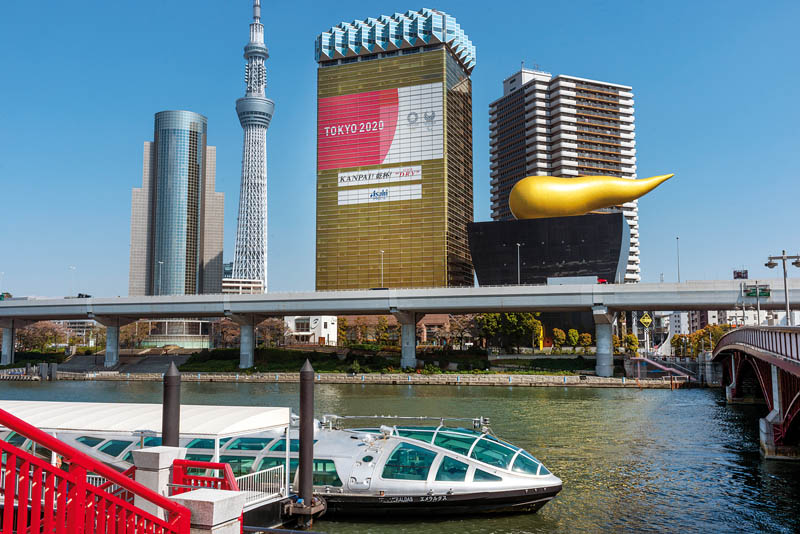

No other city in the world has undergone so many changes in its appearance as Japan’s capital city.
In 1998, for the first time in history, the number of people living in cities around the world was greater than those living in rural areas. This phenomenon is by no means unique in Japan. It is clearly visible everywhere, and especially along the old Tokaido road where – from Tokyo to Nagoya to Kobe – one conglomeration merges into the next.
The biggest one, of course, is Tokyo. With 38 million inhabitants, so-called Greater Tokyo is the world’s most populous metropolitan region. It also ranks as the largest metropolis in terms of corporate headquarters and total bank deposits – a rather worrying fact when we consider the region’s history of natural disasters.
This kind of unchecked development usually results in many serious structural and social problems – Italian journalist Vittorio Zucconi once said that if Rome had the same population it would quickly become another Calcutta (now Kolkata). Yet, while not exactly a paradise on Earth, Tokyo has brilliantly managed to avoid many of the ills of intense urbanisation. It may be polluted and congested, but it has a relatively low crime rate, an efficient public transport network, and friendly neighbourhoods.
Architecture in Japan is renowned for its consistent high quality and precision finish, the result of across-the-board discussions to ensure coordinated teamwork. That’s why in the last 30 years Tokyo has become a go-to place for many lovers of architecture.
In particular, central Tokyo (the 23 special wards which comprise what in the past used to be called Tokyo City) might be the first city in the world to function as a laboratory for experiments in the urbanized future of mankind. This ‘total city’ never ceases to change and reinvent itself, with buildings and sometimes entire neighbourhoods suddenly disappearing and being replaced by something completely different.
Constantly reshaped by man-made and natural disasters as well as the rules of the real-estate market, nothing is sacred and anything goes. Only in Tokyo, after all, could a masterpiece like Frank Lloyd Wright’s Imperial Hotel have been unceremoniously knocked down after surviving a major earthquake and the Second World War.
Tokyo is a place that elicits strong reactions. It is impossible to remain indifferent: you either love it or hate it. The same thing can be said about its appearance. In many respects, Tokyo could be called the most beautiful ugly city in the world.
First-time visitors are likely to experience visual trauma as they encounter a city that spreads everywhere in a seemingly chaotic way, which people used to more traditional notions of urban design might find difficult to grasp. In Tokyo, everything is random. With nothing resembling urban planning or zoning laws, a recognisable shape or a clearly defined skyline, this city excels in detail, and it is a place where its parts are always more in focus than the whole.
As some observers have noticed, the only accepted norm is unplanned coexistence.
The labyrinthine character of this city (most Japanese streets have no name, and the Japanese system of addresses has been devised to drive people crazy) is such that losing your way is easy and in a sense even desirable. It’s much more fun to wander around without a guide book or even your smartphone, get lost and find new unexpected marvels and oddities round every corner (without fear of being mugged or worse) including outstanding or bizarre constructions with no connection to their surroundings. This is also true for residential housing (particularly two or three-storey private homes), a field in which young upcoming architects have the opportunity to experiment and put new ideas into practice.
The cityscape of Tokyo is remarkable for its almost complete absence of built continuity.
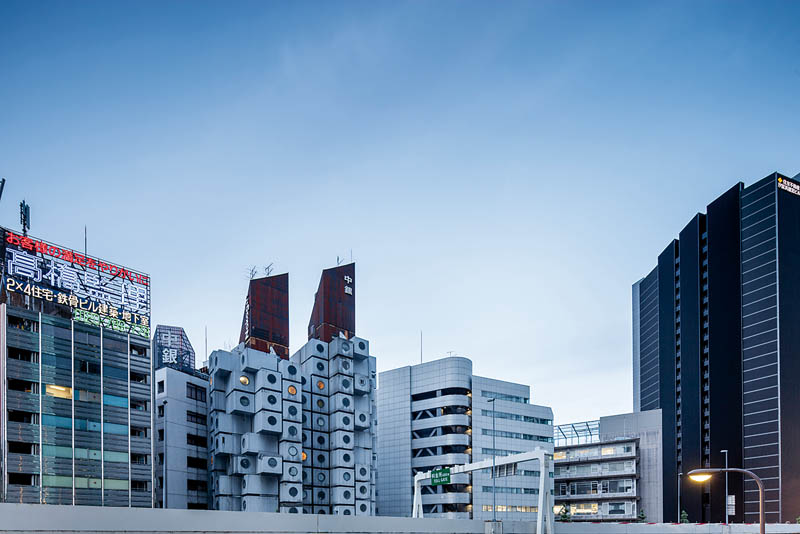
Alternating very small and colossal buildings with glazed, aluminium and concrete surfaces appear one after another. At night, the lighting transforms Tokyo into a fantastical apparition of artificial, electric mountain ranges and deep canyons.
It takes time, but eventually you realise that Tokyo, far from being chaotic, is divided into different ecosystems. Tokyo, in other words, is not a city of space, like most Western urban entities, but a city of situations; an agglomeration of villages or specific neighbourhoods, each one with its own distinctive character, devoted to a particular trade (musical instruments in Ochanomizu, kitchen utensils in Kappabashi, textiles in Nippori, second-hand and rare books in Jinbocho). People gravitate toward a certain district according to their interest or shopping desires.
It seems that throughout the 20th century, at 20-year intervals, events of cataclysmic proportions have had an immense affect on the look of Tokyo. In 1923, for instance, the old, traditional city dating back to the Edo period (1603-1876) was almost completely laid waste by the Great Kanto Earthquake, which killed more than 140,000 people, destroyed 570,000 homes and left almost two million homeless.
The reconstruction work that followed in the 1920s and ‘30s offered a unique opportunity to redesign the city according to a modern, more rational approach, but in the end nothing came of it. However, the government financed an ambitious plan for residential building that resulted in 16 new settlements called Dojunkai (Mutual Profit Associations): modern three-storey condos (apartment blocks) built in reinforced concrete around a courtyard. Then in the 1930s, the Modern Movement was responsible for a series of striking architectural works marked by sober functionalism such as Yoshida Tetsuro’s central Post Office headquarters (still standing to this day).
Twenty years after the earthquake, another disaster – this time a man-made one – struck the Japanese capital when American aerial bombing flattened the reborn city once again. A quarter of the city was razed to the ground, half the houses were destroyed and 250,000 people died. Yet, once again, Tokyo was rebuilt, even though this time the government placed quantity over quality in order to meet the demand for residential housing. This period of frantic reconstruction culminated in the completion, in 1958, of the 333-metre tall Tokyo Tower – a veritable architectural giant in a city where at the time even the tallest buildings did not exceed eight or ten storeys.
In the 1960s, Japan put aside past customs and aesthetics and adopted radical modernisation. Tokyo became a marketplace and laboratory willing to embrace new ideas and technology without stopping to ponder the negative side-effects of such a choice, looking to the future instead of relying on tradition. In this respect, the 1964 Olympic Games served as a great stimulus for redevelopment. The authorities wanted to show the world what Japan had achieved since the war, and Tokyo began to be known as the city of the future because it was not afraid to experiment and embrace the new, even at the cost of doing away with tradition and risking failure.
In the 1960s, for instance, the Metabolist group of visionary architects was dreaming of houses in the sky, residential units that could be put on a truck and moved anywhere one wanted, and floating cities. Tange Kenzo, in particular, unveiled his Tokyo Plan for 15 Million Inhabitants, calling for the expansion of the city out over the bay by means of gigantic structures to be built over the water.
The foreign community of architects and assorted creatives began to take notice. Russian director Andrei Tarkovsky saw the still young Tokyo Metropolitan Expressway (created for the Olympic Games) as a vision from the future and came all the way from Europe to film long, hypnotic, dream sequences for his 1972 work, Solaris. Ten years later, Ridley Scott would make Blade Runner, modelling his 2019 Los Angeles on a very contemporary Shinjuku with its millions of lights and advertisements, and the giant video screens showing inviting almond-eyed women.
Again, 20 years after the Olympics, the economic Bubble brought unprecedented levels of prosperity and unleashed a plethora of ambitious projects, with new office and commercial structures becoming the face of Japan’s economic boom and dramatically altering the face of Tokyo. On one hand, corporate clients demanded flashy structures that both served as an advertising tool and attracted clients. On the other hand, many architects embraced the extreme exaggeration of post-modernism, designing buildings where quotation, simulation, collage and imitation – conveniently sold to their clients as freedom of design – were the new key words. With seemingly unlimited budgets and almost complete freedom, they came up with the most baroque, logic-defying creations. Even someone like Kuma Kengo, who is now famous around the world for his wooden structures and whose stated goal is to recover traditional Japanese architecture, was responsible, in 1991, for M2, a building that could be mistaken for a “love hotel”, where Western elements – especially a massive, six-story high Ionic column – were transformed into pure kitsch.
The ultimate in show-off architecture was represented by foreign-led projects. Thanks to the strong yen, local companies were able to invite famous Western architects to produce increasingly flamboyant creations. Typical examples are the works by Nigel Coates and Philippe Stark. The former was given the chance to erect two buildings next to each other: the Penrose Institute of Contemporary Arts and The Wall. The Penrose Institute – London’s ICA’s sister gallery – was probably too avant-garde, too out there for the hedonistically frivolous Nishi Azabu crowd. The building with its four imposing Doric columns is still there, but the art gallery has been replaced with a tamer though decidedly more welcome restaurant.
The real show stopper, however, is its neighbour: the Wall. Facing a much more austere Ando Tadao-designed building, it abruptly introduces ancient Roman history onto an otherwise anonymous street. Apparently, Italian bricklayers were flown in to apply the finishing touches to create an artificially ruined wall. Needless to say, even this fake old building houses a restaurant.
As for Philippe Stark, he “gifted” Tokyo with a spectacular and mysterious object created for Asahi Beer, one of Japan’s main brewing companies. Standing next to their new headquarters, the Stark-designed beer hall is a black granite building topped with his 360-tonne Flamme d’Or (The Golden Flame) sculpture, said to represent both the “burning heart of Asahi Beer” and a frothy head of foam.
The bursting of the economic Bubble not only put a stop to the extravagant building frenzy, it also brought to light the huge scale of the bid-rigging practices that had been going on for years in the construction industry. However, it never stopped the building. It only put an end to the most outlandish constructions. If anything, the first two decades of the new century have further enhanced the reputation of Japanese architects, several of whom have gone on to win the coveted Pritzker Prize, the architectural equivalent of the Nobel Prize.
During the whole of the last century, a constant element in this almost continuous cycle of destruction and rebirth has been the contrast between constantly changing buildings and an almost unchanging street plan dating back to pre-modern, pre-industrial times. The result is that the architects have to adapt their designs to strangely shaped plots of land, often resulting in triangular and other oddly shaped structures, or the famous narrow buildings, which look almost two-dimensional.
Built at the tail end of the Bubble years, Marion Botta’s Watari Museum of Contemporary Art is an apt example of the way in which the client’s needs and the architect’s vision often clash with the environment where they plan to erect their building. However, in the case of the Watarium (as the museum is often called), the man-made damage dated back to a more recent event, the 1964 Olympic Games. The sporting event was preceded by a period of hectic planning that resulted in many hurried decisions. In this specific case, a new road, Gaien-nishi-dori, was constructed to link Shinjuku and Shinagawa, slashing through many residential districts without regard for the narrow streets and old rectangular plots that had survived to that day. As Botta wrote in the presentation of his project, “Tokyo exacerbates the contradictions of modern cities”. This forced him to come up with “a strong and precise image that had to resist the confusion and contradiction of languages, styles and forms present in Tokyo”.
Nowadays, Tokyo looks like a shapeless blob trying to contain an ever-expanding human community. Its population had reach one million in 1884. Irresistibly attracted by the seemingly endless opportunities the capital offered, more and more people kept pouring in. Thirty years later, at the time of the disastrous earthquake, four million called Tokyo home; in 1941, when Japan declared war on the United States and Great Britain, the population had already ballooned to over seven million. The Pacific War brought death and destruction, but by the time the 1964 Olympic Games celebrated the country’s return to the world stage, Tokyo already boasted over 10 million people. Today, the Tokyo Metropolis boasts 13 million people, and some two million buildings are squeezed into its central 23 wards where nine million Tokyoites live.
Tokyo presents a bewildering array of modern architecture which has been built almost entirely since the beginning of the 20th century. Widely (and wildly) divergent in style and scale, buildings exist side by side among a confusing clutter of signs, vending machines and overhead power lines. At times, the visual and aural onslaught is unbearable. Particularly in the commercial districts, the streets present so much visual information that the environment seems indecipherable.
In this constantly re-forming metropolis, buildings have always been treated as disposable objects, easily demolished or replaced, following the simple, straightforward logic of economic interest. Why waste a prime piece of land on a beautiful, historically and culturally important nine-storey or – God forbid – three-storey building (e.g. Frank Lloyd Wright’s old Imperial Hotel) when we can erect a 20 or 30-storey skyscraper and sell all that office and residential space to businesses, shops, restaurants and tenants.
The concept of cultural preservation is unknown in Japan. Many aspects of local culture – not only architecture – are overlooked, even denigrated by the Japanese until they are discovered and praised abroad. Only then do the Japanese start to see their own culture with different eyes. It happened to ukiyoe prints when Japonism became fashionable in France, and it happens every time an artist or film become successful in Europe or America.
The same thing can be said about archiving material. Public institutions are in the habit of discarding any item that according to their narrow point of view is not worth keeping. Photos, documents, artefacts, etc. anything goes, unless someone inside that institution is particularly devoted to preserving them for the sake of future generations.
In architecture, one of the main battles currently taking place is between property speculators and conservationists, with the latter group desperately trying to save a number of important buildings.
Take the Nakagin Capsule Tower. Even today, this tall pile of boxes with round windows looks quite impressive. Not everybody likes it, but personal taste aside, for many years this creation by the late Kurokawa Kisho represented one of the very few Metabolist projects that did not remain on paper but were actually realised.
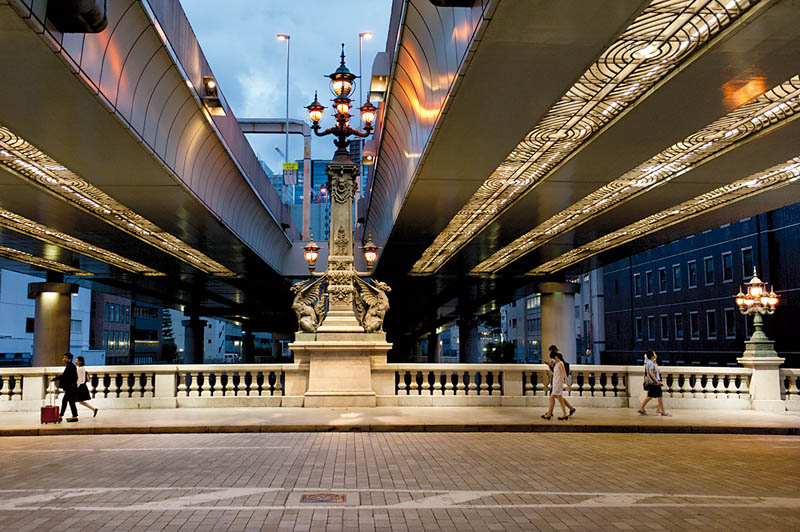
However, if you want to take a closer look you will have to hurry because, like many other historical buildings, its days may be numbered. Built in 1972, it was conceived as a sort of biological organism whose cells (tiny apartments only ten-square-metre wide) were theoretically flexible and interchangeable as they could be moved to other similar sites.
50 years on, the structure has not aged very well. The original units/cells should have been replaced 25 years ago. Instead, they are still there, clinging to a rusting central tubular structure. Currently, there is a hard fought battle taking place between those who want to save it and those – including most of the apartment owners – who want to tear it down and replace it with a new building.
Unfortunately, the Nakagin Building is just one of many such cases. In fact, more than one hundred historical buildings are at risk of being demolished, according to Docomomo Japan, an association belonging to an international organisation, which since 1988 has been fighting to protect important architectural works. The main problem is that the Japanese government is traditionally more than happy to back the developers’ interests. For example, a new law promulgated in 2002 further liberalised city planning, partially doing away with regulations concerning building height and location wherever a new project included a park.
Developers, for their part, seem devoid of sentiment or nostalgia for the past. Every time they have to choose between renovating a historic building (which means replacing all the electric and mechanical features) and erecting a brand-new structure, they invariably choose the latter option.
The sad result is that in the last 20 years one historical building after another has succumbed. In Tokyo alone, just to give a few examples, in 2007 Mitsui Fudosan tore down the Sanshin Building, an elegant construction dating back to 1930, which was famous for its splendid entrance hall that featured an ornate ceiling and many small decorative details. In 2009, it was the Sofitel Tokyo Hotel’s turn. Facing Ueno Park, this hotel stood out thanks to its unusual shape inspired by both the Tree of Life and traditional Buddhist temples.
Even the above-mentioned Dojunkai condominiums are no more. Built between 1924 and 1934 and easily recognisable thanks to their beautiful ivy-covered walls, quite incredibly they all survived wartime air raids, but they couldn’t escape the developers’ bulldozers. The very last one was demolished in 2013, but the most famous among them, in Aoyama, had already been disposed of ten years earlier to be replaced by Omotesando Hills, a pretty unremarkable creation – part shopping mall, part luxury apartments – made of concrete and glass stretching for 250 metres along Omotesando Avenue.
If the Dojunkai had been located in Europe or America, they would most probably have been converted by altering and improving the original structure in order to keep its original exterior while adapting the interiors to modern needs. Sadly, this solution is too complicated and time consuming. Eventually, a tiny fragment of the Dojunkai was preserved for old times’ sake.
It should be noted that this lack of empathy for historic buildings does not even spare the work of famous architects. Frank Lloyd Wright, for instance, realised five projects besides the Imperial Hotel. However, only two of them survive. As for his ill-fated hotel, you can still admire its entrance and the central portion at Meiji Mura, an architectural museum near Nagoya.
Back to our list of outstanding but undeserving victims: the Hotel Okura was closed in 2015 for major renovation. Since 1962, it had been considered one of Tokyo’s classier hotels (it’s not a coincidence that James Bond stays here in Ian Fleming’s You Only Live Twice). The new version was unveiled last year – a 38-storey glass tower (18 of them devoted to office space) where, interiors aside, nothing of its former charm remains.
According to German architect Ulf Meyer, the real problem lies in the fact that Tokyo is the only city in the world where any piece of land is about ten times more valuable as anything anybody could ever build on it. Taking this into consideration, no work of architecture can have any claim to last, so Japanese architects can never aspire to build long lasting monuments.
In the end, Tokyo is an ephemeral city that never seeks permanence. It is forever incomplete.
Defining such a place remains extremely difficult. Tokyo can hardly be judged or appreciated by applying some of the parameters typically used when looking at a city. Think about Rome, Paris, London or New York, and there are some images that immediately come to mind; places and monuments that have come to symbolise them and contribute to their myth.
Now think about Tokyo.
I bet you would be hard pressed to come up with a definite image. The stereotypical impression that people get by reading articles and books or watching TV programmes is a jumble of buildings and signs and colours with no discernible order or direction. Tourist postcards usually feature a rather underwhelming skyline (West Shinjuku) or a sea of reinforced concrete with a weird red-and-white pylon in the middle – the Tokyo Tower. When, in the 1980s, the above-mentioned Italian journalist Vittorio Zucconi was sent here to work as a foreign correspondent, he looked down from the window of his airplane and was reminded of a room in which a kid had just scattered several boxes full of building blocks over the floor. It was a polite and imaginative way of saying that Tokyo was, ultimately, an ugly city.
What unique landmarks can Tokyo boast about? Take, for example, the Tokyo Tower. Imagine the Eiffel Tower, but slightly different in shape. The Japanese version is 330 metres high, 30 metres higher than the French tower. Unfortunately, it’s been painted white and red (well, technically it’s called “international orange”). The overall effect is totally different: the ever-proud French have turned a mountain of iron bars into a national symbol. The Japanese have turned the same amount of iron into a giant pylon.
More recently, the Tokyo Tower has been overshadowed by the much higher Tokyo Skytree?… The Big Toothpick?! Forget it.
In the end, probably Tokyo’s most outstanding architectural feature is a vast network of roadways that weave their way through the high-rises and over long stretches of the capital’s rivers and canals before diving underground and under Tokyo Bay.
The Expressway is unique to the Tokyo cityscape and is still very much a work in progress nearly 60 years after the first section was completed in 1962 – again in preparation for the Olympic Games. Originally conceived to connect all the Olympic venues, it was quickly seen as a practical way to solve central Tokyo’s unmanageable traffic congestion.
I mentioned rivers and canals. Tokyo used to be full of beautiful waterways along which people conducted business and enjoyed themselves. Alas, today many of them are literally overshadowed by the Expressway (it was built on top of them in order to avoid paying landowners), and make for a very sad sight. Other small rivers were even more unlucky as they were either filled in or turned into culverts.
When dealing with Tokyo, we probably have to take the good with the bad because they are inextricably linked. In any case, whatever your opinion of the city, Tokyo never allows you to take her for granted, and it is this ever-changing chaos that hides most of the city’s charm. It seems that here things are allowed to grow, develop, change and die according to a natural inner rhythm, like a living organism, in which beauty is to be found in the easily overlooked small things.
The combination – sometimes the clash – of new and old and the ceaseless input of new cultural imports from around the world give the city an energy you can hardly find anywhere else. It’s the excitement of urban culture in the process of constant creation and reinvention.
Gianni Simone

